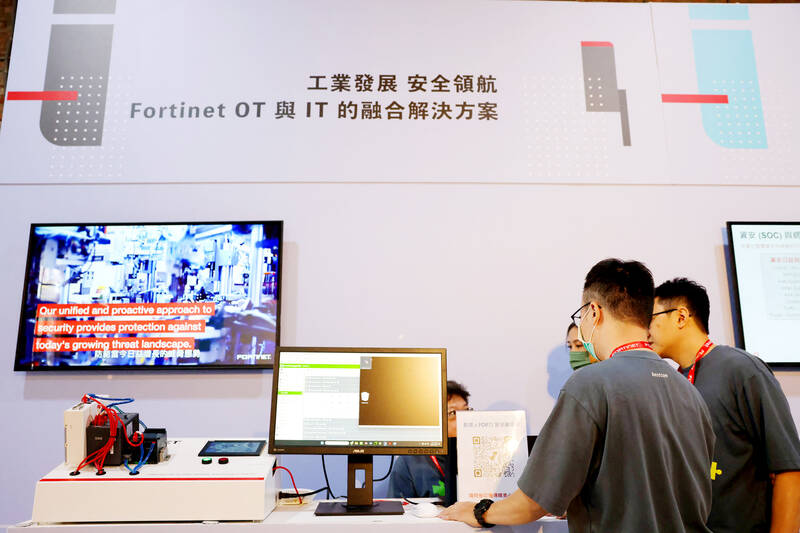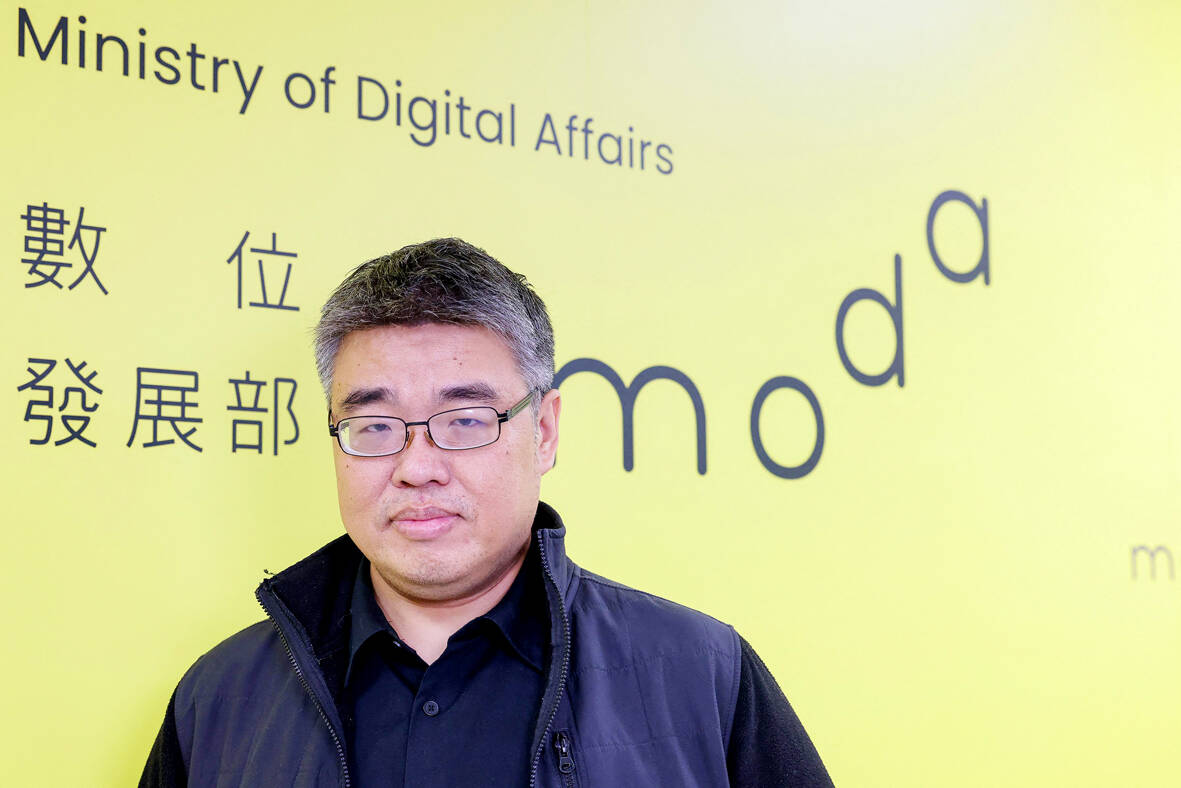Millions of people offline, banks knocked out and the world’s most advanced semiconductor industry paralyzed — Taiwan’s doomsday scenario includes not just invading Chinese troops but also a wave of attacks against its cyber infrastructure.
Taiwan’s security planners run simulated worst-case scenarios constantly to prepare for the day Beijing decides to try and take over.
If China does invade, officials and cybersecurity experts say it will not limit its assaults to security forces and defense infrastructure, but effectively disconnect Taiwan from the world.

Photo: AFP
Taiwan is facing a persistent threat from stealthy attackers who gain access to computer networks to “sit and wait within the victim’s infrastructure”, said Crystal Tu (杜貞儀), a cybersecurity researcher at the Institute of National Defense and Security Research.
They can be highly active during a time of conflict, Tu said, such as a “cyber operation aimed at the disruption of critical infrastructure — including telecommunications, energy and finance sectors.”
Cyberattacks have ramped up dramatically in the year leading up to the presidential and legislative elections today.

Photo: AFP
Taiwanese authorities have said government agencies face an estimated five million cyberattacks a day.
And the cybersecurity firm Fortinet reported an 80 percent increase in cyber attacks in the first half of last year — ranking Taiwan number one in Asia Pacific.
“The cyber operation toward Taiwan never really stops,” said Tu.
Some tactics used against infrastructure have been identified as techniques used by Chinese state-sponsored groups.
Last year, Microsoft flagged the threat from a group named Flax Typhoon that operates out of China and targets Taiwan.
The US tech giant said Flax Typhoon “intends to perform espionage and maintain access” to various Taiwanese organizations for as long as possible.
SEMICONDUCTORS
Cyberattackers have not only targeted the government and defense organizations, but also hit the semiconductor industry.
Taiwanese companies are crucial to the supply of chips, the lifeblood of the global economy.
Such is their importance that one former US official said last year that the US would rather destroy this semiconductor infrastructure than let it fall to invading Chinese forces.
Last year, Taiwan Semiconductor Manufacturing Company (TSMC), which controls more than half of the world’s chip output, reported a data breach at one of its suppliers.
“Taiwan is an important target because it is at the top of the critical high-tech supply chain,” said Fortinet’s Jim Liu. “Geopolitics and (China-Taiwan) relations could inevitably increase cybersecurity incidents.”
China has increased diplomatic and military pressure since 2016, when pro-status quo Tsai Ing-wen (蔡英文) of the Democratic Progressive Party became president, a policy that William Lai (賴清德) is expected to follow.
WORSE CASE SCENARIO
China’s increasing aggression towards Taiwan, including simulated blockades of the island, has fueled speculation among policymakers about Beijing’s potential timeline — and methods — for an invasion.
In the digital realm, officials say China could go beyond cyberattacks and effectively cut off the country from the rest of the world.
“Because Taiwan is an island, all communication with the outside world relies on undersea cables,” said Taiwan’s deputy digital minister Lee Huai-jen (李懷仁).
“The worst-case scenario is all our undersea cables are cut off.”
To prepare for that, Taiwan is looking to the sky.
Lee said that Taiwan is working with two foreign satellite service providers to collaborate with the island’s largest telecom company.
Satellite receivers will be placed in 700 spots across Taiwan “to test whether we can switch communication systems” during times of crisis, he said.
“The first thing... is to maintain the stability of the government’s command system and maintain the accuracy of the information provided” to civilians, he said.

This month the government ordered a one-year block of Xiaohongshu (小紅書) or Rednote, a Chinese social media platform with more than 3 million users in Taiwan. The government pointed to widespread fraud activity on the platform, along with cybersecurity failures. Officials said that they had reached out to the company and asked it to change. However, they received no response. The pro-China parties, the Chinese Nationalist Party (KMT) and Taiwan People’s Party (TPP), immediately swung into action, denouncing the ban as an attack on free speech. This “free speech” claim was then echoed by the People’s Republic of China (PRC),

Exceptions to the rule are sometimes revealing. For a brief few years, there was an emerging ideological split between the Democratic Progressive Party (DPP) and Chinese Nationalist Party (KMT) that appeared to be pushing the DPP in a direction that would be considered more liberal, and the KMT more conservative. In the previous column, “The KMT-DPP’s bureaucrat-led developmental state” (Dec. 11, page 12), we examined how Taiwan’s democratic system developed, and how both the two main parties largely accepted a similar consensus on how Taiwan should be run domestically and did not split along the left-right lines more familiar in

As I finally slid into the warm embrace of the hot, clifftop pool, it was a serene moment of reflection. The sound of the river reflected off the cave walls, the white of our camping lights reflected off the dark, shimmering surface of the water, and I reflected on how fortunate I was to be here. After all, the beautiful walk through narrow canyons that had brought us here had been inaccessible for five years — and will be again soon. The day had started at the Huisun Forest Area (惠蓀林場), at the end of Nantou County Route 80, north and east

Specialty sandwiches loaded with the contents of an entire charcuterie board, overflowing with sauces, creams and all manner of creative add-ons, is perhaps one of the biggest global food trends of this year. From London to New York, lines form down the block for mortadella, burrata, pistachio and more stuffed between slices of fresh sourdough, rye or focaccia. To try the trend in Taipei, Munchies Mafia is for sure the spot — could this be the best sandwich in town? Carlos from Spain and Sergio from Mexico opened this spot just seven months ago. The two met working in the